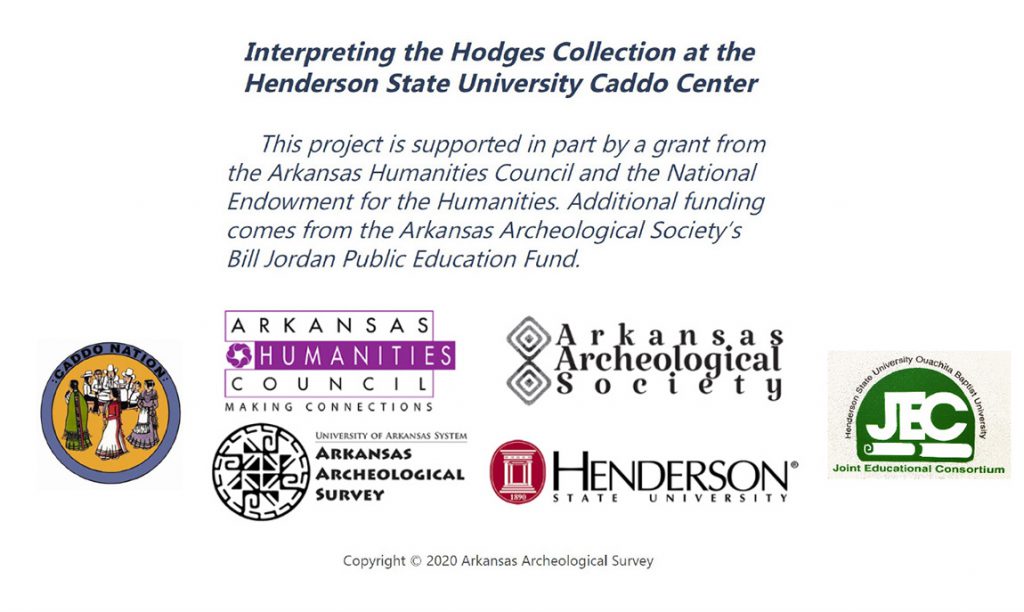As part of a project to interpret the Joint Educational Consortium’s Hodges Collection of Native American Artifacts, the Arkansas Archeological Survey is launching a new website. “Interpreting the Hodges Collection at the Henderson State University Caddo Center” will enhance the experience of both in-person and virtual visitors. This project is supported in part by a grant from the Arkansas Humanities Council and the National Endowment for the Humanities. Additional funding comes from the Arkansas Archeological Society Bill Jordan Public Education Fund.
In 2019, staff from the Arkansas Archeological Survey’s Henderson State University Research Station moved the Joint Educational Consortium’s Hodges Collection of Native American Artifacts to open curation in the renovated Caddo Center on campus. The Joint Educational Consortium, Inc., a cooperative educational venture between Henderson State University and Ouachita Baptist University in Arkadelphia, acquired the collection in 1977. Thomas and Charlotte Hodges amassed their large collection in the 1930s and 1940s. Most objects came from archeological sites in Clark and Hot Spring counties in southwest Arkansas, with some collected from Arkansas County sites in southeast Arkansas. The people living in these areas were likely ancestral to the Caddo and the Quapaw.
 Using a small grant from the Arkansas Archeological Survey’s Hester Davis Fund, a team from Fayetteville traveled to Arkadelphia in November 2019 to document objects in the collection using 3D scanning technology. The Arkansas Archeological Survey’s 3D digital imaging lab has been funded in part by the Roy and Christine Sturgis Charitable and Educational Trust.
Using a small grant from the Arkansas Archeological Survey’s Hester Davis Fund, a team from Fayetteville traveled to Arkadelphia in November 2019 to document objects in the collection using 3D scanning technology. The Arkansas Archeological Survey’s 3D digital imaging lab has been funded in part by the Roy and Christine Sturgis Charitable and Educational Trust.
In 2020, with funding from the Arkansas Humanities Council and from the Arkansas Archeological Society Bill Jordan Public Education Fund, we have developed interpretive materials in several different media. Using these two grants, the Hodges Collection can be an educational resource on campus for university students, faculty, and staff, and for members of local communities. With the development of the new website, we can extend it to more distant visitors via the internet. The website hosts short videos and 3D models of selected objects in the Hodges Collection. More pages will be added in the future. Visitors to the Caddo Center can access the videos and 3D models via their smartphones and on a touchscreen monitor set up in the hall. In addition, we created wall text and new brochures to explain the significance of the collection and the history of the Caddo people in the Arkadelphia area.
We are excited to show new ways of viewing objects in the Hodges Collection to educate people about Arkansas’s history. With the new website, we hope to reach more distant visitors who might not be able to come to the Caddo Center in person.
This project is supported in part by a grant from the Arkansas Humanities Council and the National Endowment for the Humanities. Additional funding comes from the Arkansas Archeological Society Bill Jordan Public Education Fund. The project coordinator is Mary Beth Trubitt, and web design is by Deborah Weddle. Tamara Francis (Tribal Historic Preservation Officer for the Caddo Nation of Oklahoma), Judith Stewart-Abernathy (retired director of the Arkansas Tech Museum), and Deborah Weddle (Arkansas Archeological Survey webmaster) served as humanities scholars for the project. The 3D models were created by Teka McGlothlin and Sarah Shepard. Mary Beth Trubitt, Rae’Shawn Jones, and Emma Adams produced the short videos.
The Caddo Center is open on the HSU campus. We follow current COVID protocols, including daily health screening and mask wearing.

